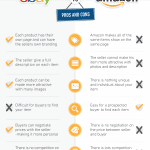
For ecommerce retailers, Amazon is undoubtedly the holy grail of sales platforms. And for good reason: over 200 million users frequent ‘The Everything Store‘ and purchase billions of products yearly, many using it as their default search engine for online shopping.
With such a wide reach and impressive year-on-year growth, it’s clear why many sellers use Amazon as their primary and often only online sales channel. All the hassle of opening accounts, gaining approval, and listing products on other smaller platforms seems a huge waste of time compared to the return on investment offered by Amazon.
However, as many seasoned sellers know, focusing all your efforts entirely on Amazon and dismissing other sales channels leaves you blind to one of the biggest opportunities for increasing your online growth: multichannel selling. Contrary to what you might think, expanding your ecommerce efforts across multiple websites and marketplaces doesn’t have to be difficult and time-consuming.
But before we get into the nuts and bolts of it, let’s first discover the reasons why looking beyond Amazon and selling through various channels is key to driving your online growth:
Often, Amazon Is Not the Lowest Price
Amazon is not cheap. Its high fees and pricing structure mean that it can often be more cost-effective to list on other sites, particularly if you sell low-margin products. If you can make money with products at the lower end of the market, you’ll want to consider platforms like eBay and Walmart, where the costs, depending on your category of goods, can be significantly cheaper.
Bypass Product and Branding Restrictions
Due to Amazon’s long list of product restrictions, sellers are often unable to list certain products, especially in categories like health and beauty, food, and apparel. Some restricted products on Amazon can be sold very well on other platforms, such as Rakuten and eBay, which have more lenient policies. Many of these sites are also more open to branding, allowing you to increase your brand awareness and build a relationship with your customers.
Take Advantage of Less Crowded Markets
Many categories on Amazon are dominated by big marketplace sellers, making it difficult for small to midsize retailers to get a foothold in their niche. However, the problem spreads much deeper, with new sellers coming online every day and Amazon driving its own fierce sales agenda.
The growing competition and formidable opponent of Amazon only push you further down the listings and force you to cut your margins. Seeking out less crowded markets can allow you to establish your presence and gain an early upper hand.
Other Channels Bring Other Benefits
New platforms are using advanced AI software to offer their own unique shopping experience. Jet’s algorithm-driven marketplace favors sellers who can fulfill goods to the customer at the lowest overall costs, making it a great opportunity for local sellers.
It’s No Longer a Hassle to Sell to Multiple Channels
Splitting your time and attention between multiple channels—each in need of continual improvement and optimization—is a recipe for disaster that often results in an incredibly low return on investment. A new wave of inventory and order management platforms aims to address this issue by helping sellers centralize and manage their data so they can focus on what’s important: driving more sales.
Case Study: From 6 to 30+ Channels and Double the Sales
One recent success story of multichannel selling is a client of Descartes Sellercloud and a successful home decor merchant. Using Descartes Sellercloud’s platform, the merchant expanded his ecommerce sales to over 30 marketplaces and doubled his revenue in just a few short months.
This merchant initially sold on six channels, including eBay, Houzz, Overstock, and Wayfair. With not enough time to update inventory, manage orders, and optimize listings on each individual site, he was already struggling to cope and making much less than his business was able to bring in.
Once he started with Descartes Sellercloud, he expanded his reach to over 30 channels, including Bon-Ton, Boscoy’s, Gilt, and other specialist markets for home decor products. While doing this, he also streamlined the management of his channels and significantly reduced the time he needed to invest. In just a few months, the merchant’s sales went from $59,537 to $118,919.34, with the combined profits from alternate sites outweighing his profits from Amazon.
The bottom line for sellers is that the world’s number one ecommerce platform does not necessarily mean it will be their number one online revenue source. Sellers should open accounts on other platforms and use a trial-and-error approach to determine which works for them. For the best results, take advantage of the specialist software services and platforms that make listing on multiple channels incredibly easy, efficient, and, as you can see, profitable.
Book a Descartes Sellercloud demo today.




